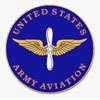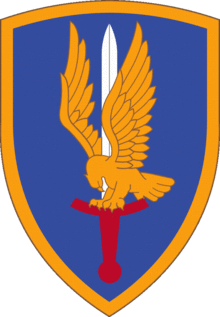United States Army Aviation Center of Excellence
| US Army Aviation Center of Excellence | |
|---|---|
| Alabama (United States) | |
 | |
| Garrison information | |
| Occupants |
|
The U.S. Army Aviation Center of Excellence, previously the Army Aviation Center and School, is the United States Army Aviation Branch's training and development center, located at Fort Rucker, Alabama. It "trains military, civilian, and international personnel in leadership skills, integrates aviation warfighting doctrine and requirements determination across the DOTMLPF, manages available resources, and sustains the U.S. Army's commitment to the well-being to its soldiers, civilians, retirees, and Families."[1] Its Commanding General is Major General Michael D. Lundy.[2]
The Center of Excellence includes three aviation brigades, the 1st Aviation Brigade, 110th Aviation Brigade, and 128th Aviation Brigade, and a Noncommissioned Officers' Academy.
History

Organic Army Aviation first entered into combat in November 1942 on the coast of North Africa. During World War II, L-4 Grasshoppers and a few larger L-5 Sentinels were used to adjust artillery fire, gather intelligence, support naval bombardment, direct bombing missions, and perform other functions. Most training of both pilots and mechanics was conducted by the Department of Air Training within the Field Artillery School at Henry Post Army Airfield, Okla., although the Army Air Forces conducted some primary training of organic Army Aviation personnel. During the Korean War, the Department of Air Training at Post Field expanded, and in early 1953, it became the Army Aviation School. As a result of the expansion of both aviation and artillery training, Post Field became overcrowded, and the Army decided to move the Army Aviation School to a different post. When no satisfactory permanent Army post was found, a temporary post, Camp Rucker, Ala., was chosen.
The Army Aviation School began moving to Alabama in August 1954 and the first class began at Rucker in October.
On 1 February 1955, the Army Aviation Center was officially established at Rucker. In October of that year, the post was given permanent status with the name change from Camp Rucker to Fort Rucker. Before the mid-1950s, the Air Force had provided primary training for Army Aviation pilots and mechanics. In 1956, the U.S. Department of Defense gave the Army control over all of its own training. Gary and Wolters Air Force Bases in Texas, where the Air Force had been conducting this training, were also transferred to the Army. Lacking adequate facilities at Fort Rucker, Army Aviation continued primary fixed-wing training at Camp Gary until 1959 and primary rotary-wing training at Fort Wolters until 1973.
The pioneer Black flying instructor Milton Crenchaw taught at then-Camp Rucker from 1954 to 1966.
In 1956, the Army Aviation Center began assembling and testing weapons on helicopters. These tests, conducted while the Air Force still theoretically had exclusive responsibility for aerial fire support, led to the development of armament systems for Army helicopters.
The 2005 Base Realignment and Closure Commission recommended that Aviation logistics establishments at Fort Eustis be consolidated with the Aviation Center and School at Fort Rucker. In the event, this did not take place. What had become the U.S. Army Aviation Warfighting Center was subsequently renamed the U.S. Army Aviation Center of Excellence on 26 June 2006.
Command and Directorates

The 1st Aviation Brigade commands four distinctly different battalions, each with a unique mission – the 1st Battalion, 13th Aviation Regiment; the 1st Battalion, 145th Aviation Regiment; 1st Battalion, 210th Aviation Regiment; and the 2nd Battalion, 13th Aviation Regiment, the former Unmanned Aircraft Systems Training Battalion at Fort Huachuca, Arizona.
The 1st Aviation Brigade traces its origins to the Vietnam War. In April 1965 the U.S. Army Aviation Brigade (Provisional) was activated with the existing 13th, 14th, 52nd, and 145th Aviation Battalions,[3] already in South Vietnam, reporting to it. In August 1965 it became the 12th Aviation Group, which then doubled in size and was used to form the 1st Aviation Brigade in March 1966.[4] Dunstan, in Vietnam Choppers writes that the numerous independent aviation companies deployed during the war's early years had become difficult to move between sectors because they had developed 'individual means of operating in conjunction with the formations they supported.'[5] Thus the brigade was formed to achieve standardisation.
Brigadier General George P. Seneff, the Staff Aviation Officer at Military Assistance Command Vietnam (MACV), became the brigade commander. Because the requirements varied in each part of Vietnam, the brigade tried to collocate one assault helicopter company with each U.S. brigade and in course of time each Republic of Korea brigade[4] The companies supporting Army of the Republic of Vietnam units were located in the most centralized positions for best support. The brigade assigned one combat aviation battalion headquarters in direct support of each infantry division and this battalion headquarters normally worked with that division no matter how many companies might be assigned for a specific mission. The Brigade Headquarters and Headquarters Company was located in Saigon from May 1966 until August 1967. Then the HQ moved to Long Binh where it remained until Long Binh was closed in the early autumn of 1972. The HQ then moved to the MACV compound at Tan Son Nhut, where it stayed until withdrawal.
At this time the 52d Aviation Battalion supported the 4th Infantry Division in the highlands, the 10th Aviation Battalion supported the brigade of the 101st and the Republic of Korea division, the 11th Combat Aviation Battalion supported the 1st Infantry Division, the 214th—the 9th Division, and the 269th Aviation Battalion—the 25th Division. The 13th Battalion, which was later to become a full group, remained in the Mekong Delta. Two aviation groups—the 17th and the 12th—supervised the aviation assets in the II and III Corps Tactical Zones respectively. The aviation group commander was also the aviation officer for the U.S. Field Force commander.
During June 1970, the 1st Aviation Brigade reached its largest size. At this time it was composed of four combat aviation groups, 16 combat aviation battalions, and 83 companies with over 4,000 aircraft and 27,000 personnel.[6] The 34th General Support Group (Aviation Maintenance and Supply) was transferred to the control of 1st Aviation Brigade in November 1971 where it continued in operation well into 1972. On the signing of the cease-fire on 28 January 1973, the Brigade strength had been reduced to 5,000 personnel and 420 aircraft in four combat aviation groups. The brigade was returned to Fort Rucker, Alabama, on 24 March 1973, and was deactivated on 6 April 1973.
According to Shelby Stanton's Vietnam Order of Battle, subordinate brigade units in Vietnam included:[7]
- 11th, 12th, 16th, 17th, 160th, 165th Aviation Groups
- the 164th Aviation Group was activated from the assets of a Provisional Aviation Group in the IV Corps Tactical Zone in 1968, and was located at Can Tho throughout its time in Vietnam. Its heritage appears to be carried out, since 1995, by the 164th Theater Airfield Operations Group at Fort Rucker.
- 10th, 11th, 13th, 14th, 52nd, 58th, 145th, 210th, 212th, 214th, 222nd, 223rd, 268th, 269th,[8] 307th, 308th Aviation Battalions
- PHANTOM, DELTA, CAPITAL, I Corps, BUFFALO Aviation Battalions (Provisional)
- 7th Squadron, 1st Cavalry Regiment, 1st Squadron, 9th Cavalry, 3-17, 7-17 Cavalry, all Air Cavalry Squadrons
On 18 February 1977 the brigade was reactivated at Fort Rucker as a training formation.[9]
Famed Vietnam War combat veteran John Bahnsen commanded the 1st Aviation Brigade in the late 1970s and early 1980s.[10]
Along with its many command responsibilities, logistical support requirements, and administrative duties, the 1st Aviation Brigade’s primary mission has been to train and develop future aviation warfighting leaders. Including the lessons learned from deployed units, instructors and cadre write, review, and coordinate Army Aviation combined arms doctrine for aviation units below brigade level.
The course curriculum consists of a wide range of professional military education subjects, with emphasis on combined arms battlefield integration. The tactical training is further reinforced with state-of-the-art simulation, allowing students to assume various command and staff positions at all command levels while fighting simulated battles throughout a wide spectrum of tactical scenarios. Equally important is the initial entry training (IET) taught to entry level Aviation Branch Soldiers. IET teaches fundamental skills for U.S. Army personnel to perform their occupational specialties in an aviation unit.[11]
The Unmanned Aerial Systems Center of Excellence (UAS CoE), as the U.S. Army UAS Proponent’s principle management agency, provides intensive, centralized total capacity management and Unmanned Aerial System integration. The CoE coordinates with all Army institutional and operational organizations, Joint and other DoD agencies as required, to achieve a coherent and sustainable UAS strategy fostering the development of relevant and responsive concepts for current, emerging and future UAS interoperability with all manned and unmanned platforms.
The UAS CoE mission statement is to provide: “integration and coordination with all Army organizations, the joint services, and other Defense Department agencies to achieve the U.S. Army UAS strategy that includes concepts for current, emerging and future UAS interoperability with all manned and unmanned systems. ”The Army UAS CoE is claimed to be composed of dedicated professionals who bring a broad wealth of knowledge, skills and experiences in their respective areas of expertise."[12]
The 110th Aviation Brigade consists of four battalions using three different sites. 1st Battalion, 11th Aviation Regiment, operates and manages air traffic control services for USAACe/Fort Rucker and the National Airspace System.[9] 1st Battalion, 14th Aviation Regiment operates from Hanchey Army Heliport and conducts graduate level training using the AH-64D Apache Longbow and OH-58D Kiowa helicopters. 1st Battalion, 212th Aviation Regiment operates from Lowe Army Heliport and Shell Army Heliport and conducts combat and night operational training, using the OH-58, UH-1, and UH-60 helicopters. 1st Battalion, 223d Aviation Regiment operates from Cairns Army Airfield and Knox Army Heliport and conducts flight training using the CH-47 Chinook helicopter and C-12 Huron aircraft.
Training
At the Centre students both learn to fly and also to employ aviation assets to assist United States forces with the 110th Aviation Brigade. Students usually spend 15–18 months in aviation school, learning a wide range of subjects, and finally graduating with their "wings" or Aviator's Badge. When second lieutenants arrive at Fort Rucker after graduating from their commissioning source (USMA, ROTC or OCS) they secure housing, they attend the two month Basic Officer Leadership Course (BOLC) at Fort Rucker. Upon completion, they join the rest of their classmates, usually junior Warrant Officers, many of whom have previous enlisted experience.
Before starting academics, students must complete Dunker training and Army SERE (Survival, Evasion, Resistance and Escape) school. After SERE, students transition to Initial Entry Rotary Wing Aeromedical Training, or "aeromed" at the U.S. Army School of Aviation Medicine. Here, they learn how flight affects physiology, toxicology, gravitational forces and other subjects pertaining to flight and the human body. The information taught in these classes is tested frequently by instructor pilots (IPs) throughout flight school.
References
- ↑
- ↑ "Commanding General USAACE and Fort Rucker" Retrieved on 4 January 2015.
- ↑ September 24th, 1963 brought to a close the 45th Transportation Battalion and gave birth to the 145th Combat Aviation Battalion.
- 1 2 http://www.1stavnbde.com
- ↑ Simon Dunston, 'Vietnam Choppers: Helicopters in Battle 1950-1975,' Osprey Publishing, 2003, 37.
- ↑ Constituted 25 April 1966 in the Regular Army as Headquarters and Headquarters Company, 222d Aviation Battalion. Activated 25 May 1966 in Vietnam.
- ↑ Stanton, Vietnam Order of Battle, 1987, 109.
- ↑ Note the 187 Asslt Hel Co served with this battalion March 1967-Apr 1971, before being transferred to the 11th Avn Bn., with which it served Apr 1971-14 Feb 72, inactivated that day. Stanton, Vietnam Order of Battalion, 113, 119.
- ↑ James W. Williams, A History of Army Aviation: From its Beginnings to the War on Terror, iUniverse, 2005, p.136
- ↑ U.S. Army Aviation Center, United States Army Aviation Digest, 1980, page 26
- ↑
- ↑
Further reading
- Lieutenant General John J. Tolson, Vietnam Studies: Airmobility 1961-1971, Department of the Army, WASHINGTON, D. C., 1973 (re-released 1989), Library of Congress Catalog Card Number 72-600371, First Printed 1973-CMH Pub 90-4
External links
- http://www-rucker.army.mil/imarucker/sites/commander/welcome.asp
- http://www.atec.army.mil/DTC/who_attc_is.htm
- 1st Aviation Brigade in Vietnam
- Official USAACE Website
Coordinates: 31°19′47″N 85°42′42″W / 31.3296°N 85.7117°W
